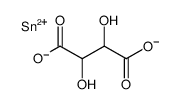815-85-0
| Name | 2,3-dihydroxybutanedioate,tin(2+) |
|---|---|
| Synonyms |
Butanedioic acid,2,3-dihydroxy-(2R,3R)-,tin(2+) salt (1:1)
Stannous tartrate (R-(R*,R*))-2,3-Dihydroxybutanedioic acid Butanedioic acid,2,3-dihydroxy-,(R-(R*,R*))-,tin(2+) salt (1:1) Lg-tartaric acid,tin (II)-Lg-tartrate Tartaric acid,tin(2+) salt (1:1) EINECS 212-427-1 Tin (R-(R*,R*))-tartrate MFCD00054358 Sn(II) tartrate Lg-Weinsaeure,Zinn(II)-Lg-tartrat |
| Boiling Point | 399.3ºC at 760 mmHg |
|---|---|
| Molecular Formula | C4H4O6Sn |
| Molecular Weight | 266.77200 |
| Flash Point | 209.4ºC |
| Exact Mass | 267.90300 |
| PSA | 120.72000 |
| Appearance | Powder | off-white |
| Storage condition | 2-8°C |
| Water Solubility | slightly soluble in water. |
|
Section 1: Product Identification Chemical Name:Tin (II) tartrate hydrate, min. 95% CAS Registry Number:815-85-0 Formula:SnC4H4O6.XH2O EINECS Number:212-427-1 Chemical Family:metal acetate salt Synonym:Stannous tartrate, Tartaric acid, tin(2+) salt (1:1)
Section 2: Composition and Information on Ingredients IngredientCAS NumberPercentACGIH (TWA)OSHA (PEL) Title Compound815-85-0100%2mg/m3 (as Sn2mg/m3 (as Sn Section 3: Hazards Identification Dust may be irritating to the nose, mucous membranes and respiratory tract. Benign pneumoconiosis may Emergency Overview: result. Primary Routes of Exposure:Ingestion, Inhalation of dust. Eye Contact:May cause slight to mild irritation of the eyes. Skin Contact:May cause slight to mild irritation of the skin. Dust may be irritating to the nose, mucous membranes and respiratory tract. Benign pneumoconiosis may Inhalation: result. Ingestion:No information on the physiological effects of ingestion. Acute Health Affects:May be irritating to skin, eyes and respiratory tract. Chronic Health Affects:Prolonged exposure to dust may result in benign pneumoconiosis. NTP:No IARC:No OSHA:No SECTION 4: First Aid Measures Immediately flush the eyes with copious amounts of water for at least 10-15 minutes. A victim may need Eye Exposure: assistance in keeping their eye lids open. Get immediate medical attention. Wash the affected area with water. Remove contaminated clothes if necessary. Seek medical assistance if Skin Exposure: irritation persists. Remove the victim to fresh air. Closely monitor the victim for signs of respiratory problems, such as difficulty Inhalation: in breathing, coughing, wheezing, or pain. In such cases seek immediate medical assistance. Seek medical attention immediately. Keep the victim calm. Give the victim water (only if conscious). Induce Ingestion: vomiting only if directed by medical personnel. SECTION 5: Fire Fighting Measures Flash Point:not applicable Autoignition Temperature:no data Explosion Limits:none Extinguishing Medium:carbon dioxide or dry powder Fire fighters should be equipped with a NIOSH approved positive pressure self-contained breathing apparatus Special Fire Fighting Procedures: and full protective clothing. Hazardous Combustion andIf involved in a fire this material may emit toxic organic fumes. Decomposion Products: Unusual Fire or Explosion Hazards: No unusual fire or explosion hazards. SECTION 6: Accidental Release Measures Spill and Leak Procedures:Small spills can be mixed with vermiculite or sodium carbonate and swept up. SECTION 7: Handling and Storage Handling and Storage:Store in a sealed container. Keep away from heat and moisture. SECTION 8: Exposure Controls and Personal Protection Eye Protection:Always wear approved safety glasses when handling a chemical substance in the laboratory. Skin Protection:Wear appropriate chemical resistant gloves and protective clothing. Ventilation:Material may form a fine dust. If possible, handle the material in an efficient fume hood. If ventilation is not available a respirator should be worn. The use of respirators requires a Respirator Respirator: Protection Program to be in compliance with 29 CFR 1910.134. Ventilation:Material may form a fine dust. If possible, handle the material in an efficient fume hood. Additional Protection:No additional protection required. SECTION 9: Physical and Chemical Properties Color and Form:off-white pwdr. Molecular Weight:266.76 Melting Point:no data Boiling Point:no data Vapor Pressure:not applicable Specific Gravity:no data Odor:none Solubility in Water:insoluble SECTION 10: Stability and Reactivity Stability:air and moisture stable Hazardous Polymerization:no hazardous polymerization Conditions to Avoid:none Incompatibility:strong oxidizing agents and halogens Decomposition Products:carbon monoxide, carbon dioxide, tin oxide, and organic fumes. SECTION 11: Toxicological Information RTECS Data:Oral (rat); TDLo: 11413mg/kg/4W-C. Oral (rat); TDLo: 37093mg/kg/13W-C. Carcinogenic Effects:No data available Mutagenic Effects:No data available Tetratogenic Effects:No data available SECTION 12: Ecological Information Ecological Information:No information available SECTION 13: Disposal Considerations Disposal:Dispose of according to federal, state, and local regulations. SECTION 14: Transportation Shipping Name (CFR):Non-hazardous Hazard Class (CFR):NA Additional Hazard Class (CFR):NA Packaging Group (CFR):NA UN ID Number (CFR):NA Shipping Name (IATA):Non-hazardous Hazard Class (IATA):NA Additional Hazard Class (IATA):NA Packaging Group (IATA):NA UN ID Number (IATA):NA SECTION 15: Regulatory Information TSCA:Listed in the TSCA inventory. SARA (Title 313):Title compound not listed. Second Ingredient:none SECTION 16 - ADDITIONAL INFORMATION N/A |
| WGK Germany | 3 |
|---|---|
| RTECS | EJ9892500 |
